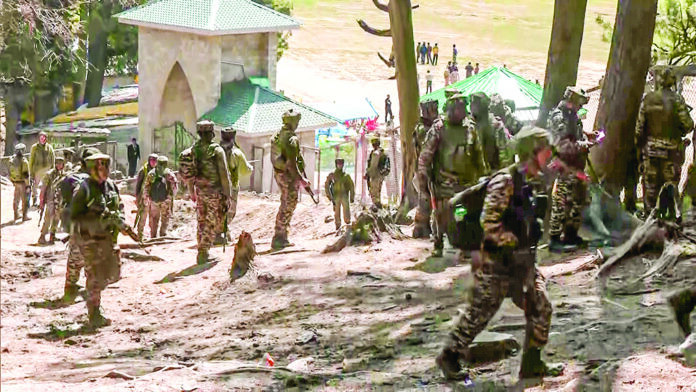
FATF grey-listing failed to deter Pakistan-backed terror attacks against India over 15 critical years.
NEW DELHI: Between 2008 and 2022, Pakistan was placed on the Financial Action Task Force (FATF) grey list on three separate occasions: from February 2008 to June 2010, from February 2012 to February 2015, and from June 2018 to October 2022. These actions were ostensibly meant to pressure Pakistan into halting terror activities, especially those targeting India.
However, an analysis of this 15-year period reveals a troubling pattern: five major terrorist attacks were carried out against India either while Pakistan was under FATF scrutiny or shortly after it exited the list—at a time when planning and infiltration for the said attacks were already underway. In each instance, the attacks were orchestrated by groups operating from Pakistani territory, including Lashkar-e-Taiba and Jaish-e-Mohammed.
This pattern of violence indicates that greylisting—FATF’s primary tool to compel financial accountability—has had virtually no deterrent effect on Pakistan’s long-standing practice of exporting jihadist violence across its eastern border. It raises a serious question: What has Delhi achieved by repeatedly presenting evidence of Pakistan’s involvement in terrorism, and how has FATF failed to dismantle the terror networks that are both controlled and unleashed by army officers at GHQ, Rawalpindi?
Following the April 2025 massacre in Pahalgam, the Indian government renewed its call for Pakistan to be returned to the FATF grey list. To support its arguments, it shared dossiers containing irrefutable evidence with relevant stakeholders.
Yet, at the joint FATF–MONEYVAL Plenary on June 12-13, 2025, in Strasbourg, France, Pakistan was not added back to the list.
FATF is funded by its 39 members, which include 37 countries and two regional organisations—the European Commission and the Gulf Cooperation Council. Each member contributes annually to the FATF budget based on a scale proportional to their gross domestic product (GDP), similar to the OECD’s Part I contribution model. The FATF Secretariat is hosted at the OECD headquarters in Paris, though its funding remains separate from the OECD’s general budget.
For the fiscal year 2022–2023, FATF had a budget of approximately €12.9 million, with most of it allocated to staff salaries, travel, meeting expenses, IT infrastructure, and administrative overhead. While FATF does not publicly disclose the exact breakdown of contributions, countries with larger economies—such as the United States, Japan, Germany, France, and the United Kingdom—are understood to be the largest funders and thus wield the most influence over FATF’s decisions.
India, a full FATF member since 2010, also contributes annually, though its exact contribution is not made public.
The recent decision not to re-list Pakistan—despite its track record and the fresh concerns raised by Indian agencies—underscores the limits of FATF’s political will, its enforcement framework, and its vulnerability to external pressure and influence.
Consider the 26/11 Mumbai attacks, which occurred in November 2008 while Pakistan was already under FATF supervision. Ten operatives from Lashkar-e-Taiba sailed from Karachi, docked on Mumbai’s coast, and launched coordinated assaults on hotels, a Jewish centre, and a railway station. For three days, the attackers received real-time instructions from handlers in Pakistan, resulting in 166 deaths and over 300 injuries. The fact that Pakistan remained on the FATF grey list during this period made little difference to the ISI’s ability to fund, train, and deploy a maritime terror unit.
Less than two years later, in February 2010, another attack struck India while Pakistan was still greylisted. A powerful bomb exploded at Pune’s German Bakery, a popular café near the Osho Ashram, killing 18 and injuring over 60. Investigations revealed Lashkar-e-Taiba’s involvement through the so-called ‘Karachi Project’, with Pakistani-American operative David Headley having previously conducted reconnaissance of the target. The bombing once again showed LeT’s continued reach—even under international financial monitoring.
Similarly, in February 2019, during Pakistan’s third stint on the FATF grey list (from June 2018 to October 2022), a suicide bomber affiliated with Jaish-e-Mohammed rammed an explosive-laden vehicle into a CRPF convoy in Pulwama, Jammu and Kashmir, killing 40 Indian security personnel. Within hours, Jaish claimed responsibility. Indian investigators later traced the radicalisation, planning, and propaganda videos to JeM’s command centres in Bahawalpur, Pakistan. This was not a rogue cell or a one-off act—it was a cross-border operation executed while Pakistan was under supposed FATF scrutiny.
Two other major attacks—though executed just after Pakistan exited the grey list in 2015—were, according to domestic and international assessments, almost certainly conceived and facilitated during the period of FATF monitoring.
In August 2015, two Lashkar-e-Taiba operatives attacked a BSF convoy in Udhampur, Jammu. One attacker was killed and the other, Mohammad Naved from Faisalabad, Pakistan, was captured alive. His interrogation revealed that the infiltration and planning had occurred weeks earlier, while Pakistan was still on the FATF list.
Just months later, in January 2016, six Jaish-e-Mohammed terrorists crossed into India and attacked the Pathankot Air Force base. The operation lasted nearly four days and killed seven Indian security personnel. It was coordinated through phone calls to handlers in Pakistan. Indian agencies submitted a detailed dossier to Islamabad and other countries, including audio intercepts and Pakistani phone numbers—but no credible action followed.
Taken together, these five attacks—Mumbai, Pune, Pulwama, Udhampur, and Pathankot—lay bare the failure of FATF’s grey-listing strategy. The assumption that financial monitoring would disrupt terror operations has simply not held. Groups like Lashkar-e-Taiba and Jaish-e-Mohammed have adapted, relying on informal networks, front charities, and cross-border handlers backed by military support.
These groups could launch such complex attacks while Pakistan was under international scrutiny points to a deeper issue: terror in Pakistan is not merely a financial enterprise—it is a strategic instrument of statecraft.
This operational reality now finds validation in academic data as well. Dr Jessica Davis, an international expert on terrorism and illicit financing and President of Insight Threat Intelligence, conducted an empirical analysis of FATF’s impact on terrorism trends using global datasets and statistical modelling. Her study found that even three years after countries are placed on the FATF grey or black list, levels of terrorism continue to rise—a pattern observed in seven out of eight models.
The implications are stark: FATF listings may generate paperwork and international signalling, but they do not demonstrably curb terrorist violence. Greylisting of Pakistan, as these attacks demonstrate, merely creates diplomatic leverage but does not stop infiltration, bombings, or the use of Pakistani soil as a launchpad for mass-casualty attacks on India.
The pattern is now too clear to ignore. FATF can measure compliance on paper, but the bloodstains on Indian soil tell another story.







